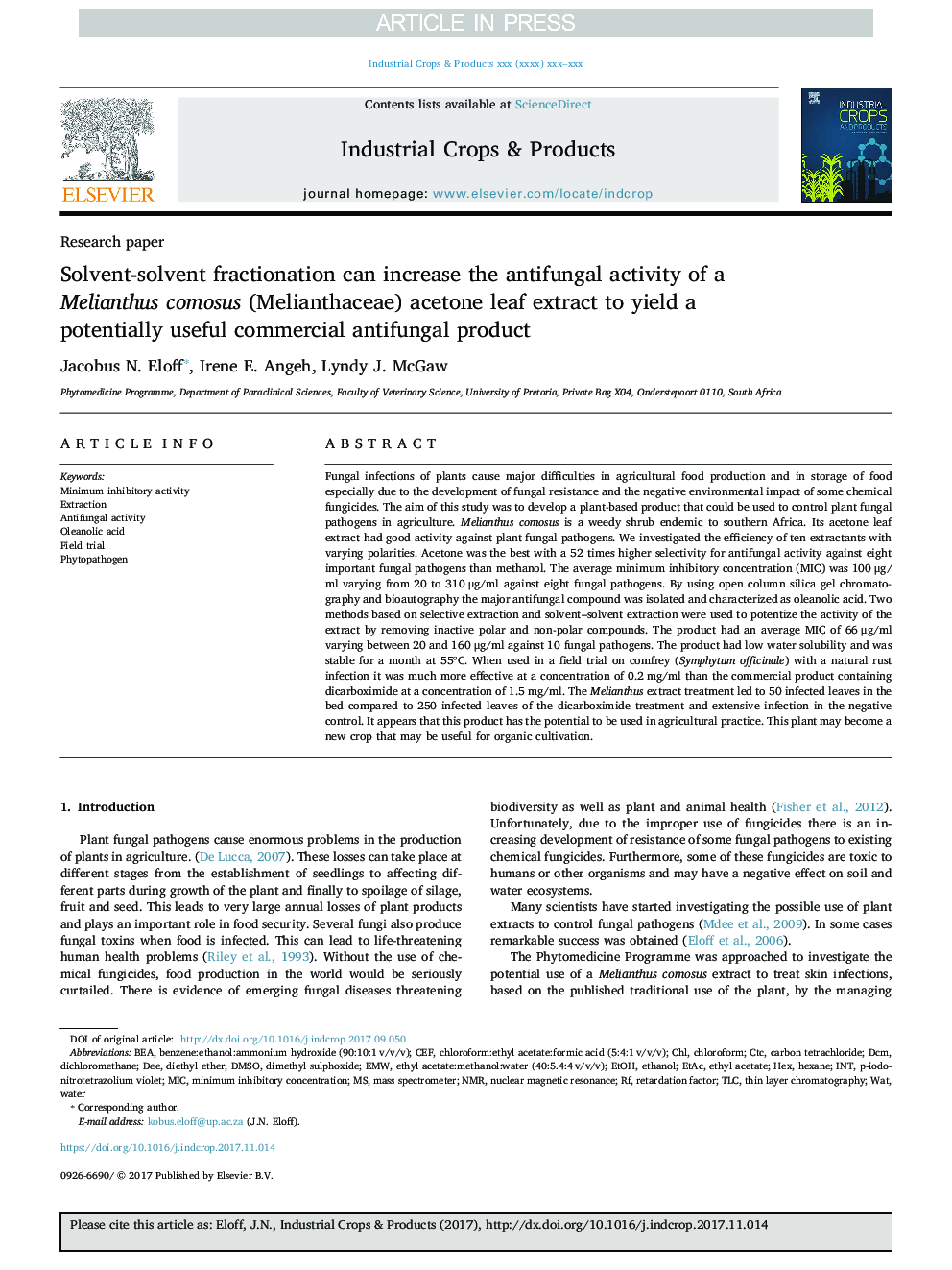| کد مقاله | کد نشریه | سال انتشار | مقاله انگلیسی | نسخه تمام متن |
|---|---|---|---|---|
| 8881002 | 1624800 | 2017 | 10 صفحه PDF | دانلود رایگان |
عنوان انگلیسی مقاله ISI
Solvent-solvent fractionation can increase the antifungal activity of a Melianthus comosus (Melianthaceae) acetone leaf extract to yield a potentially useful commercial antifungal product
دانلود مقاله + سفارش ترجمه
دانلود مقاله ISI انگلیسی
رایگان برای ایرانیان
کلمات کلیدی
p-iodonitrotetrazolium violetChlintCEFBEATLCMICEtOHDCMEtAcDEEEMwCTCnuclear magnetic resonance - رزونانس مغناطیسی هستهایDMSO - DMSOWater - آبEthanol - اتانولEthyl acetate - اتیل استاتExtraction - استخراجOleanolic acid - اسید اولانیولیکNMR - تشدید مغناطیسی هستهای Minimum inhibitory concentration - حداقل غلظت مهاریDiethyl ether - دی اتیل اترdimethyl sulphoxide - دی متیل سولفوکسیدDichloromethane - دیکلورمتانRetardation factor - ضریب عقب ماندگیmass spectrometer - طیف سنج جرمیAntifungal activity - فعالیت ضد قارچیPhytopathogen - فیتوپاتوژنField trial - محاکمه میدانHex - هگزاhexane - هگزینWAT - چیCarbon tetrachloride - کربن تتراکلریدthin layer chromatography - کروماتوگرافی لایه نازکChloroform - کلروفرم
موضوعات مرتبط
علوم زیستی و بیوفناوری
علوم کشاورزی و بیولوژیک
علوم زراعت و اصلاح نباتات
پیش نمایش صفحه اول مقاله

چکیده انگلیسی
Fungal infections of plants cause major difficulties in agricultural food production and in storage of food especially due to the development of fungal resistance and the negative environmental impact of some chemical fungicides. The aim of this study was to develop a plant-based product that could be used to control plant fungal pathogens in agriculture. Melianthus comosus is a weedy shrub endemic to southern Africa. Its acetone leaf extract had good activity against plant fungal pathogens. We investigated the efficiency of ten extractants with varying polarities. Acetone was the best with a 52 times higher selectivity for antifungal activity against eight important fungal pathogens than methanol. The average minimum inhibitory concentration (MIC) was 100 μg/ml varying from 20 to 310 μg/ml against eight fungal pathogens. By using open column silica gel chromatography and bioautography the major antifungal compound was isolated and characterized as oleanolic acid. Two methods based on selective extraction and solvent-solvent extraction were used to potentize the activity of the extract by removing inactive polar and non-polar compounds. The product had an average MIC of 66 μg/ml varying between 20 and 160 μg/ml against 10 fungal pathogens. The product had low water solubility and was stable for a month at 55áµC. When used in a field trial on comfrey (Symphytum officinale) with a natural rust infection it was much more effective at a concentration of 0.2 mg/ml than the commercial product containing dicarboximide at a concentration of 1.5 mg/ml. The Melianthus extract treatment led to 50 infected leaves in the bed compared to 250 infected leaves of the dicarboximide treatment and extensive infection in the negative control. It appears that this product has the potential to be used in agricultural practice. This plant may become a new crop that may be useful for organic cultivation.
ناشر
Database: Elsevier - ScienceDirect (ساینس دایرکت)
Journal: Industrial Crops and Products - Volume 110, 30 December 2017, Pages 103-112
Journal: Industrial Crops and Products - Volume 110, 30 December 2017, Pages 103-112
نویسندگان
Jacobus N. Eloff, Irene E. Angeh, Lyndy J. McGaw,